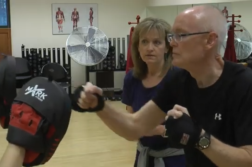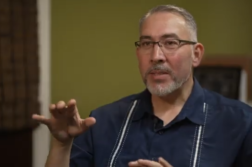Joe Verghese, M.D., Professor of Neurology and Medicine at Albert Einstein College of Medicine and Director of the Montefiore Einstein Center for the Aging Brain in New York, talks about a new technology that could provide an early warning system for Parkinson’s disease.
Interview conducted by Ivanhoe Broadcast News in April 2016.
What are problems associated with aging and what we can do to intervene and see if there is something that can be done earlier? Let’s start there and ask you about the link between mobility and cognition, the ability to move and mind health?
Dr. Verghese: Sure.
Is there a link?
Dr. Verghese: Absolutely. We take walking for granted; it’s something that we automatically do. For the most part in daily life, walking is automatic; but if you have a challenging circumstance, say you’re walking outside on the street and you’re talking to someone, then your brain has to not only figure out how to walk, but also how to talk. Dividing attention sometimes is a problem either when you get old or when you have early stages of disease in the brain like Alzheimer’s, or Parkinson’s, or strokes. The difficulty to do what seems like a simple task like walking, and more so, a more complex task like walking while talking might be the first sign that there’s some disease process in the brain that’s happening, and we could use this information to identify people at risk.
The study that you’re doing with the fNIRS, how does that help pinpoint some of these potential problems?
Dr. Verghese: One of the main limitations of studying walking patterns in older people is that most of the current imaging techniques don’t allow us to image a person while they’re walking. fNIRS is functional near infrared spectroscopy. This is a light based technology that allows us to measure the blood flow in the front part of the brain. So what it allows us to do is we can actually see what is happening in the brain while somebody is walking. What we discovered is that during normal walking, the brain is engaged, but more so during a challenging condition where you get people to walk and talk. Then you can actually see the brain activity ramping up to deal with the challenge.
When you’re able to identify these potential signals in real time, what are the implications? What could be done with that information down the road?
Dr. Verghese: There are a few things I think that these results lead to. One, is we can identify people at risk. In this particular study, where we looked at three groups of people; we looked at normal people, we looked at people with Parkinson’s disease and then interestingly, an in-between group of people who have some features of Parkinson’s disease, but not severe enough to meet the criteria for the disease. What we found is that a simple task, just asking them to stand still, patients with Parkinson’s disease had difficulty doing; they sway. Whereas, people with the mild Parkinson’s signs, they don’t look like they have a problem doing it until you examine the brain using the fNIRS and then you discover they’re actually straining their brain to do a simple task. This might be one of the earlier signs that the brain is dysfunctioning and it precedes obvious clinical signs. From a research, as well as a clinical practice perspective, hopefully it will not only helps us identify people at risk, but maybe this is something we can target; if we can have interventions that improve brain activity and function down the road we can improve the way people walk. We can prevent them from falling, maybe we can prevent further cognitive decline.
The only other question I was going to ask you in terms of a message to people, is there is anything I didn’t ask or one thing that you would want people to know about the research that you’re doing here?
Dr. Verghese: The focus of our research is to understand how the brain is involved in thinking, moving, feeling and how all these activities go together. In, the traditional research world, people who study cognitive problems haven’t focused as much on motor function. Our research is showing that, there’s a link between both of these. You literally can’t walk without a brain and, understanding the mind body connection, hopefully, will give us a better understanding of what are the earliest changes that occur when you get a disease like Alzheimer’s or Parkinson’s disease. How do we identify it and potentially, how do we develop interventions that can prevent the disease from getting much worse? The work that we do in our laboratories over here and in our population studies is something that we translate over to our clinical practice. For instance, in the Center for Aging Brain where we see patients an important aspect of the assessment is, if somebody comes with memory complaints, is not only asking about the memory complaints and testing them with memory tests, but also asking them about their walking, finding out if they’re falling and actually examining their walk while they’re in our clinic to get a better understanding of the kinds of problems that patients face.
Specifically with some of this research, it’s Parkinson-like symptoms that seem to be able to be picked up by the fNIRS?
Dr. Verghese: No, the focus of this study was for Parkinson-like symptoms, but the fNIRS also picks up problems, in seemingly normal people who might be at the earliest stages of Alzheimer’s disease or patients who have poor circulation in the brain. They also have difficulty with certain tasks that require the brain to switch attention between walking and talking. And the fNIRS allows us to actually quantify the effort that the brain is putting into these kinds of activities.
END OF INTERVIEW
This information is intended for additional research purposes only. It is not to be used as a prescription or advice from Ivanhoe Broadcast News, Inc. or any medical professional interviewed. Ivanhoe Broadcast News, Inc. assumes no responsibility for the depth or accuracy of physician statements. Procedures or medicines apply to different people and medical factors; always consult your physician on medical matters.
If you would like more information, please contact:
Deirdre Branley
Public Relations
718-430-2923
Deirdre.branley.einstein.yu.edu
Sign up for a free weekly e-mail on Medical Breakthroughs called
First to Know byclicking here.




